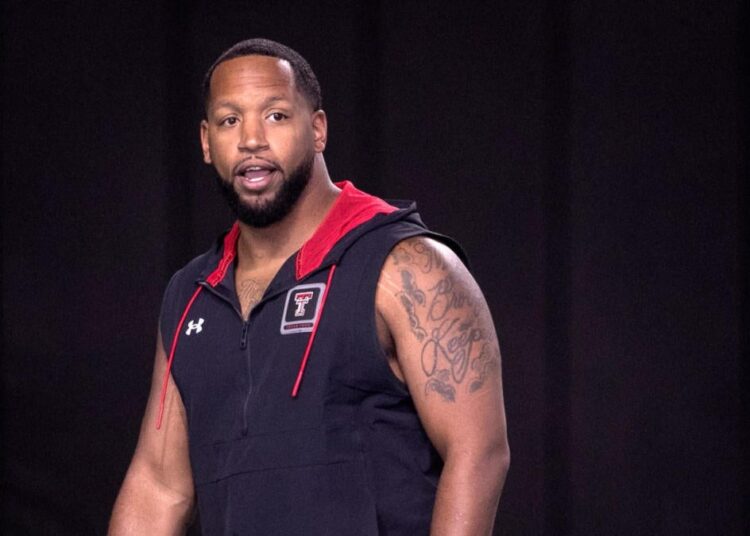At 25, James Blanchard thought he had it made. With a growing family living near the Texas Gulf Coast, he was making six figures. On the side, Blanchard had carved out enough time to pursue his passion, scouting high school players in the state.
One problem: The day job wasn’t enough to satisfy him. Blanchard wasn’t fulfilled. That job was building fire hydrants.
“Literally putting together fire hydrants,” Blanchard told CBS Sports. “From the bare bones of painting them, putting the brass in them, nuts and bolts, tighten them down — 10- to 12-hour days with your hands coming home with cuts and calluses on you.
“For years I was thinking, ‘We’ve got to be running a Ponzi scheme. Where are all these fire hydrants going? We would build 150 fire hydrants a day. I’m like, ‘Guys, the math isn’t adding up.'”
The day job served a purpose, but only in a bottom-line way to feed his family. Those player evaluation skills — with all the variables to challenge him — eventually landed Blanchard in the front row with the most desired college job this side of rush chairman.
When Baylor linebackers coach Joey McGuire was hired as Texas Tech’s 16th head coach in November 2021, he was accompanied on the private plane by one staffer on the trip to Lubbock. McGuire would have it no other way. James Ke’L Blanchard, now 34, just completed his third season as Texas Tech’s general manager of the football program.
The GM title in some programs is now second in importance only to the head coach. They are part banker, part financier, part human resources, part negotiator, part coach, part salary capologist — sometimes all those things at once.
Here’s how it happened.
The evolution
Geoff Collins is largely considered Patient Zero in the GM game. Except Collins wasn’t called a general manager. In 2006, no one was. At the time he was Western Carolina’s defensive coordinator looking for something better. He and Catamounts linebackers coach Matt Rhule decided to drive 19 hours from Cullowhee, North Carolina, to Dallas for the American Football Coaches Association convention.
It was there Collins interviewed with then-Georgia Tech coach Chan Gailey for a director of high school relations position. The interview went OK, but Collins wanted to stay on the field as an assistant. An idea formed on the drive back.
“The whole time Matt and I are brainstorming,” Collins recalled. “The NFL has director of player personnel, general managers. I’m going to float it to Chan. I’m going to call myself that. Then one day it helps me back on the field coaching.”
Gailey went for it, basically told Collins he could call himself whatever he wanted, just come run recruiting. Collins was named — or named himself — what is believed to be the first college director of player personnel. Georgia Tech then signed a top-15 class in 2007 with Collins running things.
Word got around. Nick Saban hired Collins the next year and signed the first of his 10 No. 1 overall recruiting classes with the Tide.
“I was really the first and the second [person] to have that [GM] role,” Collins said proudly.
That Alabama player personnel staff in 2007 was an incubator. It included Patrick Suddes, currently the North Carolina GM. Ed Marynowitz would go on to a number of college and NFL personnel positions. He is currently a coaches’ agent for Creative Artists Agency.
Suddes and Marynowitz are such GM legends they conduct an annual player personnel symposium.
The exact job description varies from program to program. But the GM these days is basically put in charge of NIL budget, roster construction and prospect identification related to it. It is especially important with $20.5 million in revenue-sharing money about to flood budgets for schools that opt in beginning July 1, following formal approval of the House settlement in April.
There has been such a proliferation of GMs that College Football Hall of Famer Andrew Luck recently returned to Stanford to help improve his struggling alma mater’s football fortunes. With his pursuit of a master’s degree and stellar college and NFL career, Luck doesn’t need the job. But he definitely wants it.
“I am a product of this university, of Nerd Nation,” Luck said upon his hiring last month. “I love this place.”
Luck’s situation will be unique in that the entire football staff, including head coach Troy Taylor, will report up to him. That is not happening at other schools, at least not yet.
North Carolina did away with any pretense last week when it hired Bill Belichick, who hired a real, live general manager for his college position. Michael Lombardi, 65, has been a respected front office voice around the NFL for the last 35 years, including a stint as GM for the Cleveland Browns.
Somewhere in the football facility there will be some sort of intersection of the old and new — Collins, the first GM, with Lombardi, the new GM. Collins is the Tar Heels’ defensive coordinator, at least for now, as they get ready to play UConn on Dec. 28 in the Fenway Bowl.
“I’m proud of the industry it has become,” Collins said. “I started it to one day go to the NFL; now the NFL has come to college.”
Sharing the revenue-share pie
Like their NFL counterparts, GMs are needed more than ever because of a glut of money being dumped into the system. The NFL has a salary cap. Colleges have that rev share number.
For starters, it is assumed that all 34 of the combined SEC and Big Ten schools will be able to afford the $20.5 million available annually to players if those institutions opt in to the House settlement. That’s a combined $680 million in new money annually injected, mostly into football. Those are conservative numbers. That $20.5 million will grow by 4% per year, reaching $33 million annually by the end of the 10-year settlement.
After those two power conferences, it’s a crapshoot as to who can afford it.
Mostly, GMs deal in money allocation. In revenue sharing, schools are following the back-pay percentages set by Judge Claudia Wilken in the House settlement. That is, 75% for football, 15% for men’s basketball and 5% each for women’s basketball and minor sports from 2016-2024. Those percentages are being used by GMs to allocate what amounts to pay-for-play going forward.
That means football programs will have $13 million-$15 million on average annually to spend on football. Then it comes down to how much to spend on each position. Blanchard said with the addition of revenue sharing, the average deal for a starting quarterback would move from $300,000-$600,000 to $500,000-$800,000.
Elite quarterback prospects, like Cam Ward a season ago, easily clear the seven-figure range.
Walker Jones, head of Ole Miss’ Grove Collective, described the priority of GM duties this way:
— Retention of current players
— Targeting players available in the portal
— High school prospects
“If anything we’ve evolved over the last two years. If anything we’ve added some structure …,” said Jones, a former Rebels captain as a linebacker in the 1990s. “We’ve got to run this like a real business. This can’t be middle-of-the-night, dark money, trying to operate in the shadows.”
Critics call college’s current player movement free agency, but there are huge differences. There are boundaries, rules, guardrails in the pros. The NFL has that negotiated salary cap. That, among other things, is collectively bargained. There are dates and rules surrounding NFL free agency.
The college structure continues to be disjointed. There is no collective bargaining, yet. Programs are currently in the middle of a 19-day portal window period that ends Dec. 28. During that time, players can leave on a whim. Transferring itself has become almost a semester-by-semester proposition.
At least in the NFL, contracts guarantee a player’s services for a period of years.
In December alone, some coaches were responsible for a combination of conference championship games, signing day, College Football Playoff preparation, bowl prep and scouring the portal. Sometimes all at the same time.
“I equate it to being in the military as a pilot,” Michigan GM Sean Magee said. “People who advance as aviators are really good tacticians. But then all of a sudden you’re in leadership positions. Now they’re in charge of squadrons, which makes it interesting.”
GMs’ growing importance cannot be underplayed. Alabama’s Courtney Morgan made headlines in August when he got a raise to $825,000. Like Blanchard, Morgan came from humble beginnings in inner-city Los Angeles to become a three-year letterman on the Michigan offensive line who started 11 games in five seasons.
In 2021 he was Jim Harbaugh’s director of player personnel when Kalen DeBoer called from Fresno State. DeBoer was taking the job at Washington. He wanted Morgan to be “a pillar in my program,” according to the Los Angeles Times.
Morgan eventually followed DeBoer to UW where a couple of years later the Huskies were playing his alma mater for the national championship. When DeBoer then went to Alabama, Morgan was one of his first hires.
That night last January in Houston when Michigan played Washington, Morgan was one of the main connecting rods of the two rosters playing each other for the national championship.
“Courtney Morgan 100% set the market,” Blanchard said. “Courtney and Coach DeBoer did what we’re building at Texas Tech. Coach DeBoer has already done proof of concept.
“They stepped up and made the biggest commitment to an off-the-field person in college football history. Courtney Morgan set the market for a Tier I blueblood school. If they legitimately feel like they’re a top-15 program in the country and they legitimately feel like they have the right guy at GM, you got to pay them.”
Since then, Blanchard has had to fend off offers from USC before the 2024 season. When Blanchard said he informed Kirby Hocutt of the interest, the Red Raiders’ AD said, “Hold on give me 10 minutes. I’m about to make a phone call.”
That call eventually landed Blanchard a new $800,000, two-year deal — $400,000 per year — that is believed to make him one of the top-five paid GMs in the country.
The race to hire GMs would choke a job fair. In February, Ole Miss hired Billy Glasscock away from Texas. To replace, Glasscock former LSU and North Carolina quarterback Brendan Harris was promoted at Texas. LSU’s Austin Thomas is one of the most respected names in the profession. Harris returned to LSU in January as senior associate AD for football administration. LSU claims on its website that Thomas was the first person in college football to hold the general manager title in 2016 with the Tigers.
ESPN’s Jordan Reid suggested the position will soon be compensated on a level with college coordinators. That means a seven-figure salary.
“What’s happened in this industry is unprecedented,” Blanchard said. “In the next three years you’re to see a personnel guy get hired and be the first million-dollar man.”
Basketball GMs have their own struggles
Texas’ Chris Ogden claims to be the first basketball GM. That basketball piece is a bit more complicated. There is significantly less money available in rev share — about $3 million to $5 million per program. There is a tendency in college to follow the NBA model, which is a percentage of the cap. The best NBA player on the team gets the highest percentage of the salary cap, 35%.
“How much of our cap [is our best player] worth?” Ogden asked rhetorically.
The math says that range would be $1.05 million to $1.75 million for a top basketball player (35% of that $3 million to $5 million). Considering Blanchard’s comments above, that’s what football is paying for one top-end quarterback on a roster of 105 players. Basketball will have a roster cap of 15 after House.
The issue, Ogden said, is if each SEC basketball program is getting the same amount in rev share, a program like Kentucky has to be upset. The Wildcats are a blueblood. It believes it should get more of the rev share pie. That’s a school-to-school decision to be made at similar programs like Kansas, Duke and North Carolina. Not accounted in this math is the over-the-top NIL contributions boosters can still make for players.
As part of its rev share announcement, Texas Tech said it would fund men’s basketball at $3.6 million.
BYU blew everyone out of the water recently when it paid a reported $5 million for No. 1 recruit AJ Dybantsa. BYU, Alabama and North Carolina all met that price, according to CBS Sports’ Matt Norlander.
“They’re [BYU] set up better than anybody right now,” Ogden added.
In April, CBS Sports detailed the duties of Alabama basketball analytics guru David Schwimmer that parallel those of a GM.
“I’m assuming the [basketball] bluebloods are going to have $6 million [in revenue sharing] and I’m going to have $3 million,” Ogden said. “How do I make up the gap?”
The question remains unanswered. And it should be pointed out no one is shedding tears for Texas football at a school where, yep, football is king. The Longhorns have figured out something in the NIL space. They are in the playoff for the second straight year. The basketball program will have to do its best.
Hail to the prosperous
Michigan football seemingly changed its whole philosophy in this recruiting cycle to weaponize its NIL and revenue sharing in its flipping of No. 1 recruiter Bryce Underwood. Magee got his start playing offensive line at Navy and was a surface warfare officer transporting Marines and Special Forces units during Operation Iraqi Freedom.
Magee then transitioned to coaching on Kenny Nuimatalolo’s staff. It was there he became a liaison to the NFL and Pentagon when quarterback Keenan Reynolds was coming out.
With Magee’s help, Reynolds eventually got a deferment to play immediately for the Baltimore Ravens. In the process, Magee caught the eye of Ravens head coach John Harbaugh. That’s how Magee ended up at Michigan in player personnel for Jim Harbaugh from 2017 to 2021.
The Chicago Bears hired him as chief of staff, where Magee did a little bit of everything.
“We were sitting there picking the grass seed for the practice field. That’s the scope of that job,” Magee said of one task with Bears GM Ryan Poles.
Last year, Oklahoma AD Joe Castiglione was determined to hire a general manager and had targeted Magee.
“I liked Sean’s whole background,” Castiglione said. “That’s the guy I was talking to about the type of person I was looking for.”
Magee was about to uproot his family and move to Norman when new Michigan coach Sherrone Moore convinced him to stay. Magee, 42, is a unicorn, the only existing college GM with NFL experience, until Lombardi officially takes over at North Carolina.
“I don’t say this egotistically,” Magee told CBS Sports at the beginning of the season. “In these types of roles I’m the only one who has been in both leagues. People think they can jump from the NFL to get these jobs. This [college] is still sales and relationships. This situation is far more synonymous with free agency than it is drafting.”
By December, it was clear that philosophy had changed. Michigan desperately needed quarterback help. Michigan had flipped Underwood, and there were reports a $10 million package had been put together for the prospect.
“We might connect with a recruit [who says] ‘Hey, we don’t even want to talk about NIL. We’re not interested in that. That’s not a deciding factor.’ Then three months later it is,” Magee said. “For us, that’s not the primary sell. We have way more to offer than that.”
Once again, Magee doesn’t want to sound arrogant, but he came up a different way.
“I’m probably the only MBA who is sitting in this role,” Magee said. “I’m probably the only quantitative economics major that’s sitting in this role. I went to the Naval Academy. I’m probably the only one of those.”
There are only 32 NFL GM jobs. Front-office types are already showing interest in moving down to FBS GM positions as a way to sharpen their skills.
“A lot of people are going to screw it up a little bit because you’re going to try to get an NFL guy,” Blanchard said, echoing Magee’s thoughts. “He knows nothing about acquiring talent. He’s used to selecting players and not having to recruit kids.”
After missing out on Magee, Castiglione cold-called Jake Rosenberg this summer. Rosenberg had left the Eagles earlier after 12 years to pursue his goal of becoming an NFL GM. He had been the Eagles’ chief strategist in player signings, acquisitions and salary cap evaluation. Since July, he has been helping Oklahoma as a freelancer, helping restructure the athletic budget in anticipation of revenue sharing.
Oklahoma also hired Randall Stephenson to be executive adviser to the president and athletic director. Stephenson, a former AT&T CEO, is refusing compensation while he makes what the school calls “recommendations for player compensation.”
“The way this has evolved, the rate at which this has evolved is requiring a structure unlike anything college athletics has seen,” Castiglione said. “We can’t be completely like pro sports because we recruit. It’s not like pro sports because we don’t have a binding, enforceable contract with the athletes. That might come.”
‘The Book’
Everyone is looking for an edge. Blake Lawrence’s “book” is the worst-kept secret in the industry. Lawrence is the co-founder of Opendorse, which calls itself the leading athlete marketplace and NIL technology company.
For a price, any school can purchase the book, now in its fourth volume. It can “make it real easy to answer questions like, what does a starting quarterback in the ACC earn on an annual basis,” according to Lawrence, a former Nebraska linebacker.
That’s the kind of information GMs need as their compass.. On the table to be tracked by GMs in the future are so-called performance bonuses, Lawrence added. Think of a player having written into his deal a bonus after playing, say, 200 snaps in a season. If that doesn’t seem like an employee-employer relationship, you aren’t paying attention.
“If you are on the field of play, then your NIL is more valuable because you are being seen,” Lawrence said. “It’s an interesting concept. Essentially we’re going to [value you] by how many times you show up on the screen.”
Kansas is a case study. Rob Ianello got the GM job in 2021 after more than 30 years as an FBS assistant coach. Part of his days are spent visiting NFL front offices to get an idea of how to spend that $20.5 million. He has asked counterparts at the Chiefs and Colts what percentage of their salary cap they spent on each position group. In that sense, Ianello’s “book” is the information he gleans from those visits.
The money isn’t the same as the NFL, but the percentage spent on those position rooms is becoming a refined science in college, the same as it is in the pros.
KU has invested in its biggest athletic capital upgrade in school history, the $450 million Gateway District project. Now a school with a top-five basketball program and the 35th-largest athletic budget is being asked to come up with an additional $20.5 million just to stay even.
Ianello relayed the anecdote of two Jayhawks at the same position seeking better NIL deals. The strain might have been too much on the budget.
“I told the position coach, ‘Which guy do you want? Pick one,'” Ianello said.
Both players stayed, but the transactional nature of the current climate hit home.
From hydrant to high life
Blanchard’s fire hydrant job served a purpose for the five years it lasted. During those late nights at home, Blanchard would watch film, text players, high school coaches and college coaches. Some would notice. Relationships were developed when Blanchard identified prospects who could play.
Utah defensive coordinator Morgan Scalley was the first college coach to notice in a meaningful way.
“You kind of know what you’re doing,” Blanchard remembers Scalley telling him. “Send me everything you’ve got.”
Blanchard eventually caught the eye of Rhule, that old friend of Collins’, who brought him to Baylor. Blanchard then followed Rhule to the NFL with the Carolina Panthers. The hierarchy was clear to Hocutt when Blanchard was McGuire’s only other staffer to board the private plane for that trip from Waco to Lubbock.
Blanchard’s employers are all in on whatever the future is about to become. Texas Tech recently became the first school to detail how it will fund revenue sharing. It starts with $15.1 million annually of that pie for football.
All of it is working so far. Texas Tech has the nation’s top transfer portal class as of Friday morning.
The progress on the field has been consistent, if not spectacular. McGuire is 23-15 in three seasons. The last Red Raiders coach to go to bowls in his first three seasons was Mike Leach in 2003. Receiver Micah Hudson — a Class of 2024 signee — was the first five-star prospect in program history.
In an ironic twist reflecting the current state of the game, Hudson has since transferred to Texas A&M.
That makes it high time to ask the hardest question. The GM job has become important, high-paying and pressure-packed. What type of person, exactly, does it take to make a difference in a job that is not yet fully defined?
“This is palpably the most change this sport is ever going to [see],” Magee summed up. “I want to run to the sound of chaos, not from it.”
Read the full article here


























